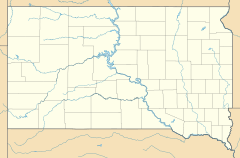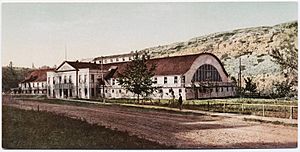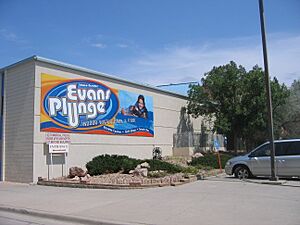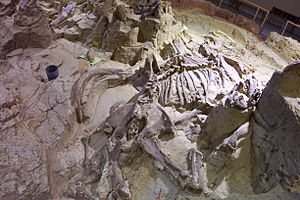Hot Springs, South Dakota facts for kids
Quick facts for kids
Hot Springs, South Dakota
Mni Kȟáta
|
|
|---|---|
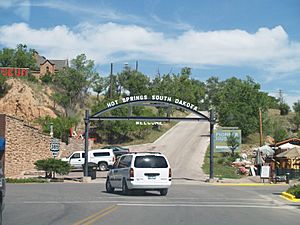
Welcome Sign in Hot Springs
|
|
| Motto(s):
"Southern Gateway to the Black Hills"
|
|
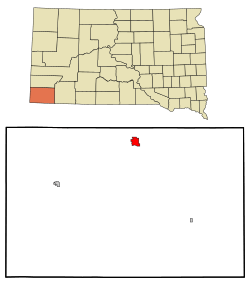
Location in Fall River County and the state of South Dakota
|
|
| Country | |
| State | |
| County | Fall River |
| Incorporated | 1890 |
| Area | |
| • Total | 4.34 sq mi (11.24 km2) |
| • Land | 4.34 sq mi (11.24 km2) |
| • Water | 0.00 sq mi (0.00 km2) |
| Elevation | 3,409 ft (1,039 m) |
| Population
(2020)
|
|
| • Total | 3,395 |
| • Density | 782.26/sq mi (302.05/km2) |
| Time zone | UTC−7 (Mountain (MST)) |
| • Summer (DST) | UTC−6 (MDT) |
| ZIP Code |
57747
|
| Area code(s) | 605 |
| FIPS code | 46-30220 |
| GNIS feature ID | 1267427 |
Hot Springs is a city in South Dakota, United States. Its name in the Lakota language is mni kȟáta, which means "hot water." This city is the main town of Fall River County, South Dakota. In 2020, about 3,395 people lived there. Hot Springs is also where some important county jobs for nearby Oglala Lakota County, South Dakota are handled.
Contents
Exploring Hot Springs, South Dakota
Hot Springs is a special place known for its warm natural springs and interesting history. It's located in the southern part of South Dakota's Black Hills.
Where is Hot Springs Located?
Hot Springs is found in Fall River County, South Dakota. The Fall River flows right through the city. The city covers an area of about 3.61 square miles (9.35 square kilometers) of land.
A Look Back at Hot Springs History
Long ago, the Sioux and Cheyenne people often visited this area. They believed the warm springs were sacred and very important.
When European settlers arrived in the late 1800s, they first called the city "Minnekahta." This was based on the Lakota name. In 1882, the city was renamed Hot Springs, which is a direct translation of the Native American name. People soon built health resorts here because of the healing warm springs.
Fun Things to Do in Hot Springs
Hot Springs is a great place for visitors, offering many exciting attractions.
Discovering Ancient Mammoths
One of the most famous spots is The Mammoth Site. It holds the world's largest collection of mammoth bones! Imagine seeing bones from animals that lived thousands of years ago.
Relaxing in Natural Hot Springs
The city is famous for its natural hot springs. You can visit places like Moccasin Springs Spa or the historic Evans Plunge. The Evans Plunge was built in 1890 and has naturally warm spring water, around 87°F (31°C).
Exploring the Black Hills and Nearby Lakes
Hot Springs is also a starting point for exploring the southern Black Hills. From here, you can easily visit Wind Cave National Park.
There are also several lakes nearby for outdoor fun:
- The Angostura Reservoir is a large lake about 10 miles (16 km) southeast of the city. It's popular for fishing, camping, and other water activities.
- Cold Brook Dam creates Cold Brook Lake, a 36-acre (14.6 hectare) lake just north of the city.
- Cottonwood Springs Dam and its lake are about 5 miles (8 km) west.
Historic Buildings and Events
The city center of Hot Springs has more than 35 buildings made of beautiful sandstone. The city is also recognized for its historic value. The National Trust for Historic Preservation named Hot Springs one of its "Dozen Distinctive Destinations" in 2009. Hot Springs also hosts the yearly Miss South Dakota pageant.
The Historic VA Hospital
Hot Springs is home to a United States Department of Veterans Affairs hospital. This hospital, once called the Battle Mountain Sanitarium, was built in 1907. It was designed to help veterans with health issues. In 2011, it was named a National Historic Landmark because of its important history. Today, it helps veterans with many different health needs.
Hot Springs Weather and Climate
Hot Springs has a cool, dry climate. It's one of the warmest places in South Dakota. This is because of special warm winds called chinook winds.
Winter Weather
Even with warm winds, winters can be very cold. Temperatures can drop below 0°F (–18°C) about fifteen mornings each winter. Snowfall averages about 31.1 inches (79 cm) per year. This is much less than other parts of the Black Hills.
Spring and Summer Weather
Spring usually arrives early, with temperatures reaching 70°F (21°C) by late March. Spring is also the wettest season, with many thunderstorms. Summers are generally hot, with temperatures often reaching 90°F (32°C) or higher. The hottest temperature ever recorded was 112°F (44°C).
| Climate data for Hot Springs, South Dakota (1991-2020 normals, extremes 1894–present) | |||||||||||||
|---|---|---|---|---|---|---|---|---|---|---|---|---|---|
| Month | Jan | Feb | Mar | Apr | May | Jun | Jul | Aug | Sep | Oct | Nov | Dec | Year |
| Record high °F (°C) | 71 (22) |
72 (22) |
86 (30) |
93 (34) |
102 (39) |
108 (42) |
112 (44) |
111 (44) |
103 (39) |
94 (34) |
80 (27) |
72 (22) |
112 (44) |
| Mean maximum °F (°C) | 58.7 (14.8) |
61.8 (16.6) |
73.7 (23.2) |
81.0 (27.2) |
88.2 (31.2) |
94.9 (34.9) |
99.6 (37.6) |
97.9 (36.6) |
95.3 (35.2) |
83.8 (28.8) |
70.4 (21.3) |
59.3 (15.2) |
101.0 (38.3) |
| Mean daily maximum °F (°C) | 40.4 (4.7) |
43.3 (6.3) |
54.1 (12.3) |
61.6 (16.4) |
70.2 (21.2) |
80.6 (27.0) |
88.5 (31.4) |
87.5 (30.8) |
79.7 (26.5) |
64.7 (18.2) |
50.5 (10.3) |
40.5 (4.7) |
63.5 (17.5) |
| Daily mean °F (°C) | 27.3 (−2.6) |
29.3 (−1.5) |
38.8 (3.8) |
46.4 (8.0) |
55.8 (13.2) |
65.7 (18.7) |
72.9 (22.7) |
71.3 (21.8) |
62.5 (16.9) |
49.0 (9.4) |
36.6 (2.6) |
27.6 (−2.4) |
48.6 (9.2) |
| Mean daily minimum °F (°C) | 14.1 (−9.9) |
15.4 (−9.2) |
23.6 (−4.7) |
31.2 (−0.4) |
41.4 (5.2) |
50.8 (10.4) |
57.4 (14.1) |
55.2 (12.9) |
45.4 (7.4) |
33.3 (0.7) |
22.7 (−5.2) |
14.8 (−9.6) |
33.8 (1.0) |
| Mean minimum °F (°C) | −9.4 (−23.0) |
−8.7 (−22.6) |
1.9 (−16.7) |
15.6 (−9.1) |
25.9 (−3.4) |
37.6 (3.1) |
45.9 (7.7) |
43.5 (6.4) |
30.6 (−0.8) |
15.6 (−9.1) |
2.3 (−16.5) |
−6.9 (−21.6) |
−18.7 (−28.2) |
| Record low °F (°C) | −41 (−41) |
−41 (−41) |
−22 (−30) |
−11 (−24) |
13 (−11) |
26 (−3) |
36 (2) |
28 (−2) |
13 (−11) |
−18 (−28) |
−21 (−29) |
−37 (−38) |
−41 (−41) |
| Average precipitation inches (mm) | 0.41 (10) |
0.57 (14) |
1.05 (27) |
2.12 (54) |
3.28 (83) |
3.05 (77) |
2.41 (61) |
2.00 (51) |
1.40 (36) |
1.40 (36) |
0.43 (11) |
0.49 (12) |
18.61 (473) |
| Average snowfall inches (cm) | 5.2 (13) |
6.3 (16) |
5.6 (14) |
4.7 (12) |
0.4 (1.0) |
0.0 (0.0) |
0.0 (0.0) |
0.0 (0.0) |
0.1 (0.25) |
1.7 (4.3) |
2.5 (6.4) |
5.5 (14) |
32.0 (81) |
| Average precipitation days (≥ 0.01 in) | 4.1 | 5.2 | 5.9 | 8.3 | 10.6 | 9.6 | 8.2 | 7.0 | 5.4 | 6.1 | 3.6 | 4.0 | 78.0 |
| Average snowy days (≥ 0.1 in) | 2.9 | 3.7 | 2.3 | 1.5 | 0.1 | 0.0 | 0.0 | 0.0 | 0.0 | 0.6 | 1.4 | 3.1 | 15.6 |
| Source: NOAA | |||||||||||||
Who Lives in Hot Springs? (Demographics)
| Historical population | |||
|---|---|---|---|
| Census | Pop. | %± | |
| 1890 | 1,423 | — | |
| 1900 | 1,319 | −7.3% | |
| 1910 | 2,140 | 62.2% | |
| 1920 | 2,141 | 0.0% | |
| 1930 | 3,486 | 62.8% | |
| 1940 | 4,083 | 17.1% | |
| 1950 | 5,030 | 23.2% | |
| 1960 | 4,943 | −1.7% | |
| 1970 | 4,434 | −10.3% | |
| 1980 | 4,742 | 6.9% | |
| 1990 | 4,325 | −8.8% | |
| 2000 | 4,129 | −4.5% | |
| 2010 | 3,711 | −10.1% | |
| 2020 | 3,395 | −8.5% | |
| U.S. Decennial Census 2017 Estimate |
|||
In 2010, about 3,711 people lived in Hot Springs. There were 1,730 households.
Population Details
- Most people (85.4%) were White.
- About 9.3% were Native American.
- A small number of people were African American (1.1%) or Asian (0.5%).
- About 2.1% of the population was Hispanic or Latino.
Households and Age
- About 21% of households had children under 18.
- Many households (42.9%) had just one person living alone.
- The average age in the city was about 49.8 years old.
- About 19.1% of residents were under 18.
- About 23.7% of residents were 65 or older.
Famous People from Hot Springs
Some notable people have come from Hot Springs:
- Albert R. Anderson – A U.S. Representative and lawyer.
- Joseph Bottum – A writer.
- Dan Dryden – An educator and politician.
- Charles S. Eastman – An attorney and state representative.
- Jarrod Emick – A musical theater actor.
- Orlando Ferguson – Known for his Flat Earth theories.
- Charles Hargens – A painter.
- Leslie Jensen – The 15th Governor of South Dakota.
- Jacqueline Left Hand Bull – A spiritual leader in the Baháʼí Faith.
- Jess Thomas – A famous opera singer.
See also
 In Spanish: Hot Springs (Dakota del Sur) para niños
In Spanish: Hot Springs (Dakota del Sur) para niños


